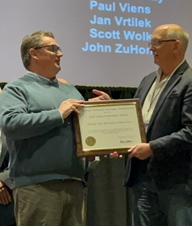HRC Update
Gerrit Schellenberger, Ralph Kraft, Dan Patnaude, Tom Gauron, & Grant Tremblay
After a wonderful celebration of Chandra's twenty-five-years-long legacy at the Symposium in December 2024, the HRC team remains thankful to be part of the Chandra family and is happy to report continued excellent performance under the new operations paradigm.
Performance of the New Paradigm
That new HRC operations paradigm was implemented in 2023 as a consequence of several HRC anomalies between 2020 and 2022 and was designed to ensure that the HRC would only operate at lower temperatures. While the impact for the users remains minimal, the obvious consequence is a segmentation of longer HRC observations into chunks of at most 15 ks, each followed by at least 30 ks without detector operations for the purpose of instrument cooling. This operations scheme has so far performed excellently; as of the end of May 2025, the HRC has completed 434 observations totalling 3.7 megaseconds since the return to science in 2023. For those who do not think in kiloseconds, that is more than 1000 hours of operation without any reoccurrence of the anomaly. This track record strongly supports the performance our implementations.

Andrew Schnell (Chandra Program Manager, left) presents the HRC award to Ralph Kraft (HRC instrument PI, right) during an award ceremony at the Chandra25 symposium. Photo by T. Connor.
To honor the tremendous efforts of the HRC and Chandra personnel responsible for returning the HRC to science, NASA recognized the entire team1 involved in the HRC anomaly resolution with a Silver Group Achievement Award. This award was formally handed over by the Chandra Program Manager to the team members during a dedicated ceremony at the Chandra 25 Year Symposium. The award plaque is now on display near the main conference room at the Chandra Operations Control Center.
Staffing Changes
The past year also featured a new change to the HRC team, with the departure of Grant Tremblay. The HRC team congratulates Grant on his new role as federal scientist at CfA leading external relations. Grant joined the HRC team in 2017 and was indispensable, especially during the 2020 and 2022 anomaly resolution. We wish him the best of success in his new role, which started in September 2024. He will remain in close contact with the HRC team as a consultant.
Ongoing Science
The HRC team is proud to contribute to Chandra's phenomenal science, with HRC results appearing in talks and posters throughout the week of the Chandra25 Symposium, including a dedicated talk by Hermann Marshall emphasizing the need for high resolution soft band X-ray instruments for studies of binaries such as SS 433.
The need for Chandra HRC was also reflected by the release of the approved targets for Chandra Cycle 26: 456 ks awarded in 10 approved HRC GO proposals reflects the higher-than-average demand of HRC, with an over-subscription factor of 5.7. As the only soft X-ray instrument with very high spatial resolution, the HRC is ideal to study proper motion, such as in the Eta Carinae system.
The HRC team has, together with the Chandra calibration team, closely monitored and quantified the loss of gain of the HRC instrument over its lifetime. While this effect is accounted for in the HRC calibration products, it impacts the sensitivity to soft sources when events do not exceed the lower PHA threshold for onboard event processing. Therefore, the HRC team has decided to alter the high voltage (HV) settings on the bottom and top plates of the microchannel plates (MCPs) in both HRC-I and HRC-S. The HRC team has already previously increased the HV settings—for HRC-I in 2021 and for HRC-S in 2012 and 2021—to counter the gain drop and recover effective quantum efficiency; however, the even faster gain drop required, once again, an increase of the high voltages on the MCPs (50V on top plate, 20V on bottom plate). On June 5th, 2024, the HRC team successfully tested the new settings during an HRC-S observation of HZ43. The live monitoring of the data stream enabled us to immediately confirm the 10-15% improvement in count rates (around 20% in pulse height amplitude). This was repeated on June 11th for HRC-S, with both tests concluding successfully.

Observation of calibration target HZ43 on June 11, 2024, to test the increase of the HV steps. The left panel shows the raw source image in detector coordinates, the middle panel plots the average source pulse height amplitude (PHA) before and after the HV increase (delimited by the vertical red lines) as a function of VCDU (time), and the right panel shows the evolution of HZ43 HRC-I count rates over the mission duration, including the most recent HV increase in orange.
1 The HRC team as well as the Chandra Flight Operations team (FOT), the Science Operations Team (SOT), and the Chandra Flight Directors (FDs)
